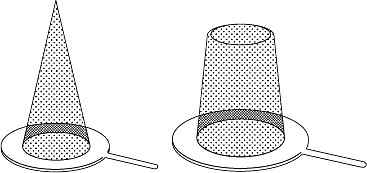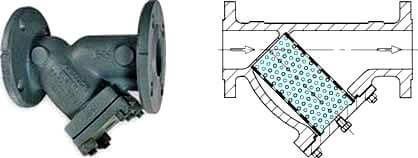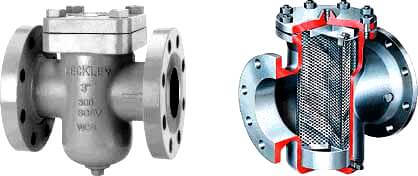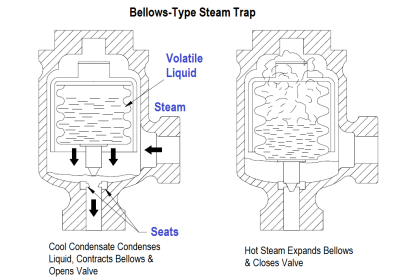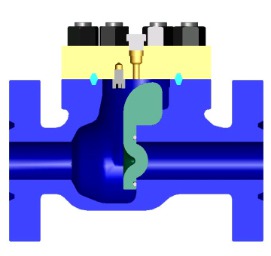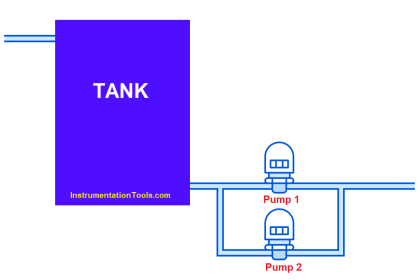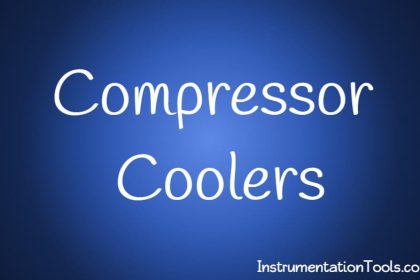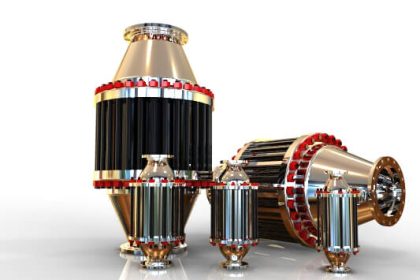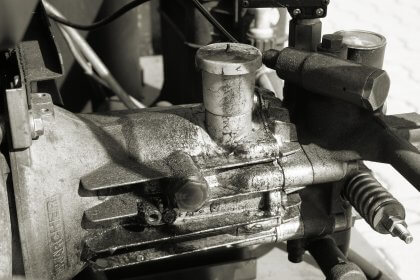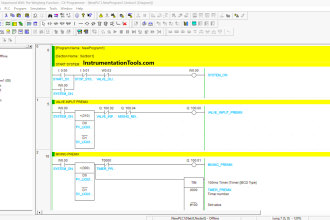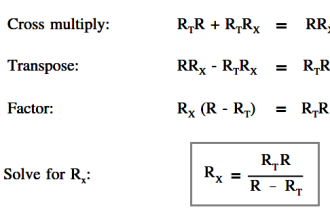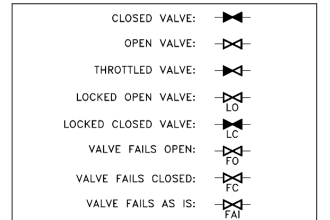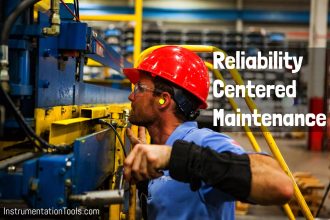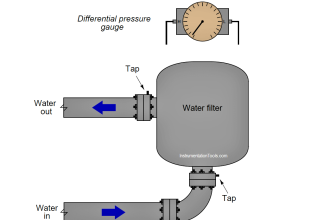Y-strainers find their ways into all kinds of applications – including food preparation, cosmetics, diesel engines, and the petroleum industry.
Y Strainer :
Y-Strainers can be installed horizontally or vertically with the leg down to catch debris.
What is a Y Strainer ?
As a refresher, y-strainers are pipe fittings which remove particulates from liquids or gas via a filtering element intersecting the main channel.
You can see a picture of a y-strainer above (to the right). Notice that the filter leg connects to the main pipe at a diagonal angle, giving the strainer its “y” shape, and hence its name.
A cylindrical strainer element – usually wire mesh with some structural support – fits into the leg. The element traps material too large to fit through the filter openings which then settles at the bottom of the leg. Periodically, the cap on the leg is removed and the accumulated dirt/trash/undissolved solution can be cleaned from the system.
Some y-strainers come with automated systems called “blow-off valves,” which make clean up much simpler. Those valves pump out the assorted gunk that has been collected with much less manual labor.
Y-strainers help protect valuable downstream equipment – like pumps, steam traps, regulators and measuring devices – which might be damaged by contaminants.
Of course, you will find y-strainers in many steam applications, for which they are considered a standard component. The part’s shape and construction make it ideal for handling high pressures put out by steam.
But y-strainers are not just used in those applications.
What is the function of a Strainer?
Strainers are important components of piping systems to protect equipment from potential damage due to dirt and other particles that may be carried by the process fluid. During system start-up and flushing, Strainers may be placed upstream of pumps to protect them from construction debris that may have been left in the pipe. The figures here below depicts typical start-up Strainers. Permanent Strainers may be installed upstream of control valves, traps, and instrutments to protect them from corrosion products that may become dislodged and carried throughout the piping system.
Centrifugal and reciprocating pumps handling material containing solids should have permanent Strainers provided in the suction lines to the pump or in the vessel from which the pump takes suction. The free area of such Strainers should be not less than three times the cross-sectional area of the suction line. The location of permanent Strainers (as contrasted to the temporary cone type which is installed at a flanged joint) also merits attention.
Y-Type Strainer
This product is designed for remove foreign matter from pipe lines and provides protection for pumps, meters, valves, and other similar mechanical equipment, which is called as Strainer. “Y” Type Strainers are named after their shape and normally used for course filtration. But with large filtration area can be used with fine mesh also. The Strainer improves the clearance in the medium, and prolongs the life of valves; protect expensive pumps, meters and other equipments. It is suitable for water, Air, Gas, petroleum, steam and other fluids.
A Y-strainer can be installed in either a horizontal or vertical position (Downward flow) with the screen element pointing downward. This allows the strainer screen to collect material in the strainer at the lowest point of the screen.
Basket Strainer
An official definition adopted by the Fluid Controls Institute is: “A CLOSED VESSEL WITH CLEANABLE SCREEN ELEMENT DESIGNED TO REMOVE AND RETAIN FOREIGN PARTICLES DOWN TO 0.001 INCH DIAMETER FROM VARIOUS FLOWING FLUIDS.” Note the term “foreign particles”. Strainers do not necessarily remove only dirt. They take out material which is not wanted in the fluid and this can sometime be a valuable product which may be saved. Basket strainers are designed for installation in horizontal lines. They are commonly used for liquid service applications.
Basket Strainers are generally used where high flow capacity is required. The basket Strainer is serviced by removing the cover, which yields access to the basket. Basket Strainers are also available in a duplex style which consists of two parallel basket Strainers and diverting valves, which permit diversion of the flow through one of the Strainer elements while the other element is being serviced-an essential feature where flow cannot be interrupted.
What’s the difference between a Filter & a Strainer?
A filter is a device that removes particles from a given liquid or gas. It includes a disposable medium for removing particles of specified micron sizes. Simply stated, a Strainer is also a filter; however, it uses a perforated plate or screen mesh to remove larger particles from a process stream. The major advantage of a Strainer is that it is reusable. There are three levels of straining a) coarse, b) medium, and c) fine.
Maintenance of Strainer :
WARNING: Before the removal or loosening of any bushing, cap, plug or cover on a strainer, extreme caution should be exercised to ensure there is zero pounds pressure in the system. Only after the system has been depressurized, should the strainer be drained for service. Service on a pressurized Strainer can cause serious injury and/or property damage.
A Y-strainer screen can be cleaned by removing the plug in the bushing, cap or bolted cover allowing the strainer to drain the loose material inside the screen. If a blow-off valve is connected to the strainer it can be opened to achieve the same result as the above. The Y-strainer screen can also be cleaned by removing the bushing, cap or cover to access the screen element.
Basket strainers with a closed bottom basket can be cleaned by removing the cap or cover and pulling out the basket screen for service. If the strainer screen is bottomless the blow-off plug can be removed allowing it to be drained and cleaned like a Y-strainer.
Care should be taken in cleaning screens. After removing a screen, it should be soaked in a cleaning solution or cleaned by using a brush. Do not allow trapped material in the screen to harden, as it will be difficult to remove. A regular cleaning schedule is recommended to avoid screens from becoming clogged.
A pressure gauge installed before and after a strainer will indicate a pressure loss due to clogging. This can help in establishing a maintenance schedule for cleaning the strainer screen. Extra screens can useful in keeping the system operating during the cleaning process.
Where are Y Strainers used ?
If you look inside a gas station pump, you’ll find y-strainers doing much of the work.
The oil and gas industry uses the large y-strainers to clean the tar, gum, and other materials out of products – from gasoline to crude oil. Oil refineries use strainers to keep harmful materials out of the pumps that run their plants.
Diesel engines use a y-strainer between the fuel tank and the fuel pump to prevent clogging caused by impurities in the diesel.
Y-strainers can be used as an intermediate or even final filtering element in biofuel production, if the straining element is able to keep out ultrafine particles.
Commercial buildings sometimes use y-strainers to keep their cooling towers and boilers from releasing scale into the water.
Chemical production operations use pipeline filters like y-strainers to ensure a cleaner product, as well as ensuring downstream equipment is not adversely affected. Likewise, the cosmetics industry uses the strainers to remove clumps of undissolved semi-solids before the product is completed.
In food production, strainers are used to remove solids, like pulp and skin, from fruit juices. Strainers are used to remove lumps from chocolate syrup and wax from honey.
In all of these industries and more, y-strainers make up a part of the fluid cleaning processes which make the products better.
Summary :
Y-Strainers are most often used in applications which don’t require frequent cleaning and where the amount of the materials to be removed is relatively low.
For processes which gather more dirt and debris, the blow-off connection allows the screen to be cleaned without taking off the strainer cap.
Reference :
- directmaterial.com
- wermac.org
Also Read : Orifice Vs Restriction Orifice

